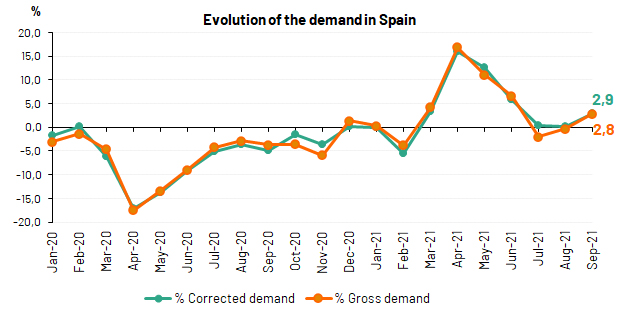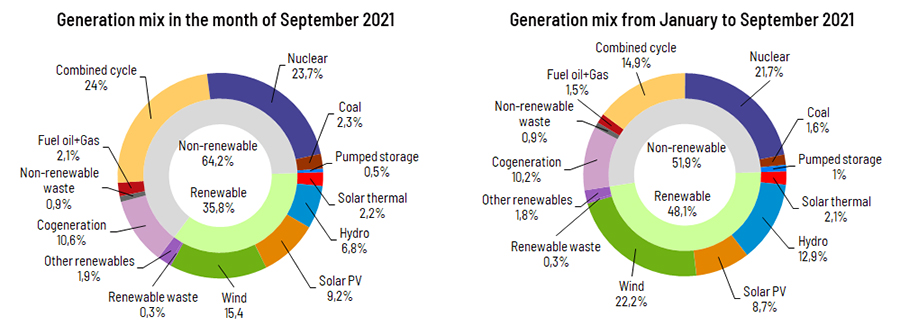- 35.8% of monthly generation came from renewable sources and 60% was obtained using technologies which produce zero CO2 equivalent emissions.
- Electricity demand grew by 34.8% in the Balearic Islands and 8% in the Canary Islands compared to September 2020.

National electricity demand in September is estimated at 21,073 GWh, a value that is 2.8% higher than the figure registered in the same month last year. After having factored in the influence of seasonal and working patterns, the figure is 2.9% higher than in September last year.

Compared to a pre-pandemic period (September 2019) and after having factored in the influence of seasonal and working patterns, national electricity demand has fallen 2.2%.
In the first nine months of 2021, demand is estimated at 192,587 GWh, a figure that is 3.4% more than in the same period in 2020. Once again, after having factored in the influence of seasonal and working patterns, demand is 3.5% higher than in the same period last year.
During the month of September, and according to data estimated at the time of this press release, generation coming from renewable energy sources represented 35.8% of the generation mix nationwide. During the month, the production of green energy stood at 7,415 GWh, which is a value that is 8.6% lower than in September 2020.
With the information available at the time of this press release, wind energy generation nationwide in September reached 3,182 GWh, a figure that is 21.5% lower than in the same month last year, due mainly to the weather conditions registered this month. Thus, in September wind accounted for 15.4% of production nationwide, being the third technology that contributed most to the generation mix during this month, only surpassed by combined cycle (24%) and nuclear, which produced 23.7%.
In addition, solar photovoltaic produced 1,909 GWh, 30.9% more than in September 2020, and accounted for 9.2% of the total generation mix.
60% of electricity production in September was obtained using technologies which produce zero CO2 equivalent emissions.

Demand for electrical energy in the peninsular electricity system grew 1.9%
Demand for electrical energy in the mainland electricity system in September is estimated at 19,752 GWh, up 1.9% compared to September 2020. After having factored in the influence of seasonal and working patterns, the demand for electricity is 2.1% higher than that registered in the same month last year.
Compared to a pre-pandemic period (September 2019) and after having factored in the influence of seasonal and working patterns, electricity demand on the peninsula has fallen 2.1%.
From January to September 2021, electricity demand on the Spanish mainland is estimated at 182,129 GWh, a value that is 3.4% higher than in the same period in 2020. In this case, after having factored in the influence of seasonal and working patterns, demand is 3.5% higher than last year.
During September, and according to data estimated at the time of this press release, 37.4% of peninsular generation came from renewable energy sources and 63.1% was obtained using technologies which produce zero CO2 equivalent emissions. For its part, wind energy generation stood at 3,069 GWh, 22.5% less than in September last year, and regarding solar photovoltaic, this stood at 1,869 GWh, up 31% on the same month in 2020.
Demand for electricity in September increases 34.8% in the Balearic Islands and 8% in the Canary Islands
In the Balearic Islands, the demand for electricity in September is estimated at 543,815 MWh, a value that is 34.8% higher than that recorded in the same month last year. After factoring in the influence of seasonal and working patterns, the figure is 31.9% up on that recorded in September 2020.
Compared to a pre-pandemic period (September 2019) and after having factored in the influence of seasonal and working patterns, electricity demand on the Balearic Islands fell 6.2%.
In the first nine months of 2021, electricity demand in the Balearic Islands is estimated, in gross terms, at 4,237,931 MWh, a figure that is 12.3% higher than in the same period in 2020.
Combined cycle, with 73.7% of the total production in the Balearic Islands, was the leading source of electricity generation in the archipelago in September, followed by generation obtained using diesel engines (10%). This month, renewable energy and those technologies which produce zero CO2 equivalent emissions accounted for 5.9% of the share in the overall generation mix of the Balearic Islands.
Furthermore, during the month, energy transferred via the Spanish Peninsula-Majorca submarine link contributed to covering 6.9% of the electricity demand in the Balearic Islands.
Regarding the Canary Islands, electricity demand is estimated at 739,472 MWh, up 8% on that recorded in September 2020. After factoring in the influence of seasonal and working patterns, the figure is 8.5% higher than that registered in the same month last year.
Compared to a pre-pandemic period (September 2019) and after having factored in the influence of seasonal and working patterns, the demand for electricity in the Canary Islands has fallen 2.1%.
From January to September 2021, electricity demand in the Canary Islands is estimated, in gross terms, at 5,914,064 MWh, a figure that is 0.7% less than in the same period in 2020.
In the Canary Islands, combined cycle, with a share of 39.4% of the total mix, was the leading source of electricity generation in September, while renewables and those technologies which produce zero CO2 emissions represented 18.4% of the total generation.
Consult our Daily Balance Report for more information on the National, Peninsular, Balearic Islands and Canary Islands electricity systems as at the close of September.